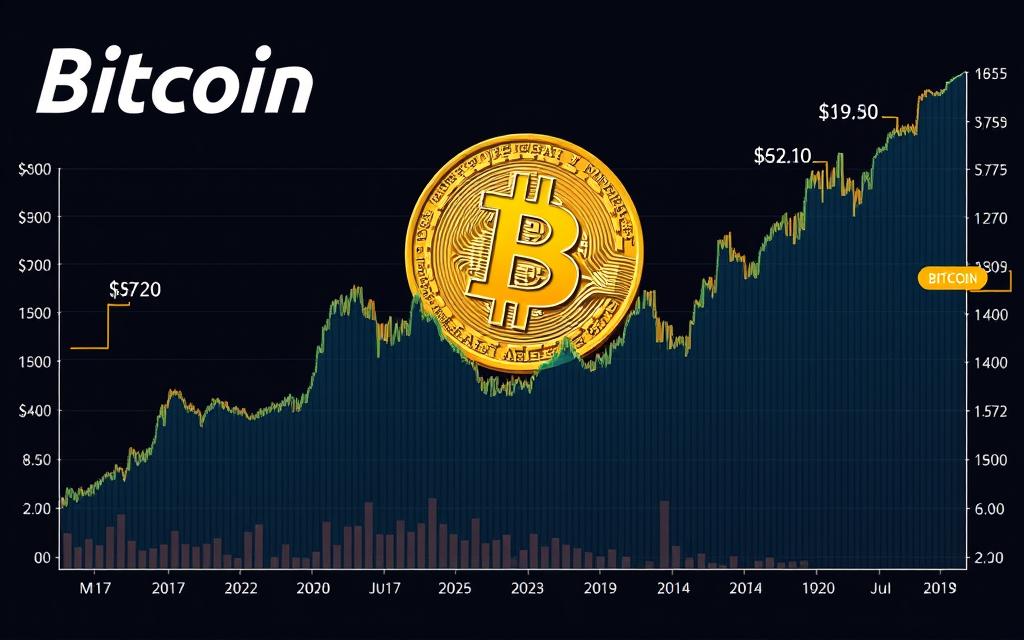Table of Contents
The cryptocurrency market is known for its volatility, and Bitcoin is no exception. As the largest cryptocurrency by market capitalization, Bitcoin’s price movements have a significant impact on the entire finance industry, leaving investors concerned about potential risks.
This comprehensive analysis examines the possibility of another significant downturn in Bitcoin’s value by exploring historical patterns, current market conditions, and expert predictions to help investors understand the potential risks and opportunities in the cryptocurrency space.
By analyzing both bullish and bearish perspectives from financial experts and cryptocurrency advocates, this article aims to provide valuable insights into the future price movements of Bitcoin, helping both experienced and novice investors navigate the uncertain finance landscape.
The Volatile Nature of Bitcoin Markets
Understanding the volatile nature of Bitcoin is crucial for any investor looking to navigate the crypto market. Bitcoin’s unstable value has made it an unviable medium of exchange, with its price fluctuating wildly, much like the value of a $10 bill changing from buying a beer one day to a bottle of fine wine the next.
Understanding Bitcoin’s Price Volatility
Bitcoin’s price volatility is influenced by a myriad of factors, making it a complex phenomenon to analyze. The crypto market is highly sensitive to news and announcements, which can cause rapid shifts in market psychology.
Several key factors contribute to this volatility, including regulatory announcements, media coverage, and technological developments within the Bitcoin ecosystem.
Key Factors Driving Bitcoin’s Price Fluctuations
The factors driving Bitcoin’s price fluctuations can be broadly categorized into several key areas:
- Regulatory announcements and their impact on market sentiment
- Media coverage and social media influence, particularly from figures like Elon Musk
- Supply constraints and the effect of “halving” events on price
- Institutional adoption and its signaling effect on mainstream acceptance
| Factor | Impact on Bitcoin Price |
|---|---|
| Regulatory Announcements | Significant price movements due to regulatory changes |
| Social Media Sentiment | Rapid shifts in market psychology influenced by influential figures |
| Supply Constraints | Scarcity dynamics influencing price, especially around “halving” events |
The interplay of these factors contributes to the complex and volatile nature of Bitcoin’s trading environment. Understanding these dynamics is essential for investors to make informed decisions in the crypto market.
Historical Bitcoin Crashes: Patterns and Lessons
Understanding the historical context of Bitcoin crashes is crucial for investors looking to navigate the volatile cryptocurrency market. By examining past market downturns, investors can gain valuable insights into the factors that drive price fluctuations and develop strategies to mitigate potential losses.

Early Bitcoin Crashes: 2011 and 2013
The early years of Bitcoin saw significant price crashes, with the first major crash occurring in 2011. After reaching a peak of around $31, the price plummeted by nearly 90% to $2.2. This crash was largely attributed to the relative novelty of Bitcoin and the lack of market maturity. In 2013, another significant crash occurred, with Bitcoin’s price dropping from around $260 to $50, representing a decline of approximately 80%. These early crashes highlighted the inherent volatility of the cryptocurrency market and the need for investors to be cautious.
The 2017-2018 Cryptocurrency Bubble
The 2017-2018 cryptocurrency bubble was characterized by a massive surge in Bitcoin’s price, followed by a sharp correction. Bitcoin’s price rose from around $1,000 in January 2017 to nearly $20,000 in December 2017, before crashing by over 80% to around $3,200 in 2018. This bubble was driven by a combination of factors, including speculation, hype, and the emergence of new investment opportunities. The subsequent crash was triggered by a decline in investor sentiment, regulatory scrutiny, and a decrease in market liquidity.
The 2021-2022 Market Correction
The 2021-2022 market correction saw Bitcoin’s price reach an all-time high of approximately $69,000 in November 2021, before entering a prolonged downtrend that took prices below $16,000 by late 2022. This cycle was unique due to the unprecedented monetary policy during the COVID-19 pandemic, with central banks globally engaging in quantitative easing that drove investors toward risk assets, including Bitcoin. Unlike previous crashes, this correction featured significant institutional participation, with companies like Tesla, MicroStrategy, and Square adding Bitcoin to their balance sheets. The crash was triggered by multiple factors, including Federal Reserve interest rate hikes, the collapse of major cryptocurrency projects like Terra Luna, and the bankruptcy of major industry players, including FTX and Celsius.
The historical analysis of Bitcoin crashes reveals several key patterns and lessons. Investors must remain vigilant and adapt to changing market conditions, as the cryptocurrency market continues to evolve. By understanding the factors that drive price fluctuations, investors can develop effective strategies to navigate the volatile crypto market.
Current Market Analysis: Where Bitcoin Stands Today
The cryptocurrency market, particularly Bitcoin, is experiencing significant shifts, making it essential to assess its current standing. Understanding the intricacies of Bitcoin’s market dynamics is crucial for investors and traders alike.
Recent Price Movements and Trading Volumes
Bitcoin’s recent price movements have been characterized by volatility, with trading volumes indicating a mix of investor sentiment. The cryptocurrency has seen fluctuations, with prices ranging between significant support and resistance levels.
Trading volumes have been a critical indicator of market activity, with higher volumes often signifying increased interest in Bitcoin. Recent data shows that trading volumes have remained relatively robust, suggesting that investors are actively engaging with the market.
Market Sentiment Indicators
Market sentiment indicators provide valuable insights into the psychological state of investors. The Crypto Fear & Greed Index, a popular sentiment indicator, currently registers in the “Greed” zone, indicating optimistic market sentiment.
Other sentiment indicators, such as social media analysis and Google search trends, offer mixed signals. While retail investors show enthusiasm, concerns about macroeconomic conditions and regulatory developments temper this optimism.
| Sentiment Indicator | Current Status |
|---|---|
| Crypto Fear & Greed Index | Greed Zone |
| Social Media Sentiment | Mixed Signals |
| Google Search Trends | Below Previous Cycle Peaks |
Institutional sentiment indicators, including Coinbase Premium and OTC desk activity, suggest continued accumulation by larger players despite short-term price volatility. Options market data shows a skew toward call options, indicating traders are positioning for potential upside.
Macroeconomic Factors Influencing Bitcoin
Understanding the macroeconomic landscape is essential for analyzing Bitcoin’s price movements. Macroeconomic factors significantly impact the cryptocurrency market, influencing investor sentiment and trading decisions.

Interest Rates and Federal Reserve Policies
Interest rates and Federal Reserve policies play a crucial role in shaping the trading dynamics of Bitcoin. When the Federal Reserve adjusts interest rates, it affects the overall liquidity in the financial markets, including the cryptocurrency market. Higher interest rates can strengthen the US dollar, making Bitcoin less attractive to investors. Conversely, lower interest rates can lead to increased investment in riskier assets like Bitcoin.
- The Federal Reserve’s monetary policy decisions directly impact the value of the US dollar.
- Changes in interest rates influence investor appetite for risk assets, including Bitcoin.
Inflation and Bitcoin as a Hedge
Bitcoin is often considered a potential hedge against inflation. As inflation rises, the value of traditional currencies can erode, prompting investors to seek alternative stores of value. Bitcoin’s limited supply and decentralized nature make it an attractive option for those looking to protect their wealth from inflationary pressures.
“The rise in inflation could challenge the US Federal Reserve’s rate-cutting outlook, potentially affecting Bitcoin’s attractiveness as a hedge.”
Some key points to consider:
- Bitcoin’s scarcity can make it appealing during periods of high inflation.
- Investors may turn to Bitcoin as a non-sovereign store of value.
Global Economic Uncertainties
Global economic uncertainties, such as geopolitical tensions and trade wars, can significantly impact Bitcoin’s price. During times of economic instability, investors often seek safe-haven assets. Bitcoin’s decentralized nature and independence from traditional financial systems can make it an attractive option during such periods.
Some factors contributing to global economic uncertainties include:
- Geopolitical tensions, such as conflicts and trade disputes.
- Economic divergences between major economies, affecting capital flows and global liquidity.
- Currency devaluation events in emerging markets, driving local Bitcoin adoption.
In conclusion, macroeconomic factors play a significant role in influencing Bitcoin’s price and trading dynamics. Understanding these factors is crucial for investors and traders looking to navigate the complex cryptocurrency market.
Will Bitcoin Crash Again? Expert Predictions

As the cryptocurrency landscape shifts, experts are offering their insights on whether Bitcoin is poised for a crash or a rebound. The predictions are varied, with some experts pointing to potential risks and others highlighting opportunities for growth.
Bullish Perspectives from Crypto Advocates
Some crypto advocates remain optimistic about Bitcoin’s future, citing its resilience in the face of past market volatility. They argue that the cryptocurrency’s value proposition lies in its decentralized nature and limited supply, making it an attractive asset for investors seeking a hedge against inflation and economic uncertainty.
Key factors driving bullish sentiment include: increasing adoption by institutional investors, advancements in blockchain technology, and the potential for Bitcoin to become a widely accepted form of payment.
According to some experts, Bitcoin’s price could surge in the coming months, driven by growing demand and limited supply. This positive outlook is based on the assumption that the global economic environment will continue to support risk assets.
Bearish Outlooks from Skeptics
On the other hand, skeptics warn that Bitcoin’s price is due for a correction, citing the cryptocurrency’s history of boom-and-bust cycles. They point to various factors that could contribute to a potential crash, including regulatory pressures, environmental concerns, and competition from other cryptocurrencies.
Key factors driving bearish sentiment include: the potential for increased regulatory scrutiny, the risk of a global economic downturn, and the possibility of a loss of confidence in Bitcoin as a safe-haven asset.
As one expert noted, “In this context, a negative scenario appears more likely—Bitcoin may end April in the $76,000-$78,000 range, with a potential drop to $52,000-$56,000 during the summer.” This prediction is based on factors such as persistent volatility, economic slowdown, and loss of confidence in Bitcoin.
Some notable skeptics, including Economist Peter Schiff and JPMorgan CEO Jamie Dimon, have expressed concerns about Bitcoin’s intrinsic value and its potential for long-term viability. Other experts, such as Economist Nouriel Roubini and Financial historian Niall Ferguson, have also raised concerns about Bitcoin’s vulnerability to regulatory pressures and its correlation with traditional risk assets.
Technical Analysis of Bitcoin’s Price Trajectory
A technical analysis of Bitcoin’s price trajectory reveals crucial insights into its potential future movements. By examining various technical indicators and chart patterns, we can better understand the potential direction of Bitcoin’s price.
Key Support and Resistance Levels
Currently, a significant support zone is identified around $78,000. This level is critical in determining whether Bitcoin’s price will continue to rise or face a downturn. The resistance levels, on the other hand, are crucial in understanding the potential upper limits of Bitcoin’s trading range.
Understanding these levels is vital for traders engaging in crypto trading, as they provide insights into potential entry and exit points.
Chart Patterns and Trend Indicators
Bitcoin’s current price action is forming a potential bull flag pattern on the daily timeframe, a continuation pattern that typically resolves to the upside if support levels hold. Various trend indicators, such as the MACD and the Ichimoku Cloud, are showing bullish signals, suggesting continued upward momentum in the market.

The MACD indicator shows decreasing bearish momentum, potentially setting up for a bullish crossover that has historically preceded significant rallies. Additionally, the Ichimoku Cloud on the weekly timeframe remains bullish, with price above the cloud and the lagging span above price, suggesting continued upward momentum.
Other indicators like the Bollinger Bands and the Parabolic SAR are also providing valuable insights into Bitcoin’s trading dynamics and potential future movements.
Institutional Adoption: Impact on Bitcoin Stability
The growing involvement of institutional investors in Bitcoin has sparked debate about its potential impact on the cryptocurrency’s price stability. As more institutional money flows into Bitcoin, the market dynamics are changing significantly.

Corporate Treasury Investments in Bitcoin
Corporate treasury investments in Bitcoin have become a notable trend, with companies like MicroStrategy and Tesla adding Bitcoin to their balance sheets. This shift has brought new buying pressure into the market, potentially influencing Bitcoin’s price. The January 2024 approval of spot Bitcoin ETFs in the United States marked a pivotal moment for institutional adoption, with products from BlackRock, Fidelity, and others accumulating over 200,000 BTC within six months of launch.
Institutional custody solutions have evolved significantly, with qualified custodians like Coinbase Custody, Fidelity Digital Assets, and BitGo providing bank-grade security for large Bitcoin holdings. This development has made it more feasible for corporations to invest in Bitcoin, further driving institutional adoption.
Bitcoin ETFs and Mainstream Financial Integration
The introduction of Bitcoin ETFs has created a new dynamic in Bitcoin markets, with regular buying pressure from these vehicles potentially offsetting selling pressure during market corrections. The accessibility of Bitcoin ETFs has expanded the investor base to include retirement accounts, financial advisors, and institutional allocators previously unable to access direct Bitcoin exposure.
The competitive fee structure among Bitcoin ETFs has benefited investors, with expense ratios falling as low as 0.19% as issuers compete for market share. Traditional financial institutions, including Goldman Sachs, Morgan Stanley, and JPMorgan, now offer Bitcoin exposure to wealthy clients, representing a significant shift from their previously skeptical positions.
However, the increased correlation between Bitcoin and traditional assets, such as gold, may call into question Bitcoin’s status as a safe-haven asset. As the market continues to evolve, monitoring the impact of institutional adoption on Bitcoin’s stability will be crucial for investors.
Regulatory Developments Affecting Bitcoin’s Future
As governments and financial institutions continue to shape the regulatory landscape, Bitcoin’s future hangs in the balance. Regulatory frameworks are evolving globally, impacting the cryptocurrency market in various ways.
US Regulatory Landscape
The United States has been actively working on cryptocurrency regulation, with various agencies taking different approaches. The Financial Stability Board (FSB) has emphasized that crypto “must be subject to effective regulation and oversight commensurate to the risks they pose.”
The US regulatory environment is characterized by a mix of strict oversight and efforts to foster innovation. For instance, the Securities and Exchange Commission (SEC) has been scrutinizing cryptocurrency exchanges and initial coin offerings (ICOs), ensuring compliance with securities laws.
- The SEC has been actively enforcing regulations on cryptocurrency exchanges and ICOs.
- The Commodity Futures Trading Commission (CFTC) has been regulating cryptocurrency derivatives.
Global Regulatory Trends
Globally, regulatory trends are shaping the future of cryptocurrency trading. Different countries are adopting varied approaches, ranging from strict regulation to outright bans.
| Country/Region | Regulatory Approach |
|---|---|
| European Union | Comprehensive framework through Markets in Crypto-Assets (MiCA) regulation |
| Japan | Pioneered cryptocurrency exchange regulation post-Mt. Gox collapse |
| China | Complete ban on cryptocurrency trading and mining |
| El Salvador | Adopted Bitcoin as legal tender |
| Singapore | Emerging as a regulated cryptocurrency hub with clear guidelines |
The global regulatory landscape is becoming increasingly complex, with international coordination efforts underway to establish consistent standards. The G20, FSB, and Bank for International Settlements are working together to ensure effective regulation.

Bitcoin’s Correlation with Traditional Markets
Understanding Bitcoin’s correlation with traditional markets is crucial for investors looking to diversify their portfolios and mitigate risk. As the cryptocurrency landscape evolves, examining its relationship with established financial systems provides valuable insights into its potential as a safe-haven asset.
Relationship with Stock Market Performance
Bitcoin’s correlation with the stock market has been a subject of interest, particularly during times of economic uncertainty. While Bitcoin is often viewed as a non-correlated asset, its relationship with stock market performance is complex and influenced by various factors, including economic indicators and investor sentiment.
During the 2022-2023 banking crisis, Bitcoin demonstrated some safe-haven characteristics, appreciating while regional bank stocks collapsed. This situational safe-haven status suggests that Bitcoin’s correlation with traditional markets can shift under different economic conditions.

Bitcoin vs. Gold and Other Safe Haven Assets
The correlation between Bitcoin and gold has risen in recent months, driven by shared drivers like inflation fears and currency devaluation. However, Bitcoin’s volatility remains significantly higher than traditional safe-haven assets, limiting its effectiveness as a pure risk hedge.
Despite this, institutional portfolio managers increasingly view Bitcoin as a small allocation within a broader safe-haven strategy rather than a replacement for traditional hedges like gold or Treasury bonds. Bitcoin’s correlation with alternative stores of value like real estate and fine art remains limited, suggesting it offers genuine diversification benefits in broader wealth preservation strategies.
The U.S. dollar remains inversely correlated with Bitcoin in many market environments, with dollar strength typically coinciding with Bitcoin weakness and vice versa. This dynamic highlights the complex interplay between Bitcoin and traditional financial markets, underscoring the need for a nuanced understanding of its correlation with various asset classes.
The Role of Market Manipulation in Bitcoin Crashes
The role of market manipulation in Bitcoin crashes is a complex issue, involving whale activity, media coverage, and investor sentiment. Market manipulation can take many forms, from coordinated efforts by large investors (whales) to influence prices, to the impact of social media and mainstream media coverage on investor behavior.
Whale Activity and Price Movements
Whale activity is a significant factor in Bitcoin’s price movements. Large investors holding substantial amounts of Bitcoin can influence the market by buying or selling large quantities, thereby affecting the price. For instance, when a whale sells a significant amount of Bitcoin, it can trigger a price drop, potentially leading to a cascade of sell orders from other investors.
- Whales can manipulate the market by placing large buy or sell orders, influencing the price.
- The actions of whales are often closely watched by other investors, who may follow their lead.
- Coordinated efforts among whales can lead to significant price movements.

Media Influence and Market Psychology
Media coverage and social media sentiment also play crucial roles in shaping Bitcoin’s price movements. Positive or negative news coverage can significantly impact investor sentiment, leading to increased buying or selling pressure. Social media platforms, particularly Twitter, have become influential in shaping market sentiment, with influential figures like Elon Musk having a substantial impact on Bitcoin’s price through their tweets.
- Social media sentiment can significantly influence Bitcoin’s price, with platforms like Twitter being particularly impactful.
- Influential figures can cause major price movements with their public statements.
- Mainstream media coverage tends to follow price action, with positive coverage during bull markets and negative coverage during crashes.
Understanding these dynamics is crucial for investors to navigate the complex and often volatile cryptocurrency market.
Technological Developments in the Bitcoin Ecosystem
As Bitcoin continues to mature, technological developments are playing a pivotal role in enhancing its ecosystem. These advancements are crucial for improving the scalability, security, and usability of the Bitcoin network.
Lightning Network and Scalability Solutions
The Lightning Network has emerged as a significant scalability solution for Bitcoin, enabling faster and cheaper transactions. This second-layer technology has been instrumental in reducing the load on the main Bitcoin blockchain, thus improving overall network efficiency. Other scalability solutions are also being explored to further enhance Bitcoin’s transaction capacity.
- The Lightning Network allows for instant transactions, reducing the burden on the main blockchain.
- Other layer 2 solutions are being developed to further scale Bitcoin.

Security Concerns and Network Resilience
Despite its robust security model, the Bitcoin network faces several challenges, including the potential impact of quantum computing on its cryptographic security. However, experts believe that protocol upgrades can address these vulnerabilities before practical quantum attacks become feasible. The network’s resilience is also being enhanced through improved mining decentralization and the adoption of renewable energy sources for mining.
For a deeper understanding of how blockchain technology works, which is fundamental to Bitcoin’s security and network resilience, you can explore resources like Demystifying Blockchain for Businesses. This will provide insights into the underlying technology that supports Bitcoin and other cryptocurrencies.
- Bitcoin’s security model has proven resilient over 15 years of operation.
- Mining decentralization has improved following China’s mining ban in 2021.
- The shift towards renewable energy is enhancing the network’s environmental sustainability.
These technological developments are crucial for the long-term success and adoption of Bitcoin. As the ecosystem continues to evolve, it is likely that we will see further innovations aimed at improving scalability, security, and usability.
Alternative Cryptocurrencies: Competition and Correlation

Alternative cryptocurrencies, often referred to as altcoins, have become crucial in understanding the broader crypto market’s behavior and its correlation with Bitcoin. The rise of these alternatives has introduced both competition and correlation, influencing the overall cryptocurrency market dynamics.
Ethereum and Other Major Altcoins
Ethereum stands out as a significant player among altcoins, with its smart contract functionality and decentralized application (dApp) ecosystem. Major upgrades and developments in Ethereum have occasionally driven market-wide rallies, independent of Bitcoin’s price movements. Other major altcoins also contribute to the diverse cryptocurrency landscape, each with unique features and use cases.
The “Bitcoin dominance” metric often decreases during bull markets as capital flows into smaller altcoins seeking higher returns. This shift indicates a growing interest in alternative cryptocurrencies and their potential for high returns, which can sometimes overshadow Bitcoin’s performance.
How Altcoin Performance Affects Bitcoin
The performance of altcoins is closely linked to Bitcoin’s price movements, with altcoins typically following Bitcoin’s direction but with amplified volatility. The correlation between Bitcoin and major altcoins increases during market stress, with most cryptocurrencies moving in tandem during significant corrections.
Innovation in alternative cryptocurrencies occasionally pressures Bitcoin to evolve. For instance, the adoption of SegWit and Taproot in Bitcoin followed advances in competing blockchains. Moreover, the collapse of major cryptocurrency projects like Terra Luna in 2022 demonstrated how failures in the altcoin space can trigger broader market selloffs affecting Bitcoin.
Investment Strategies During Bitcoin Volatility

The cryptocurrency market’s inherent volatility demands a cautious and informed investment approach. As Bitcoin continues to be a significant player in the crypto space, investors must be prepared to adapt their strategies to navigate the market’s fluctuations effectively.
Dollar-Cost Averaging and Long-Term Holding
Dollar-cost averaging is a strategy that involves investing a fixed amount of money at regular intervals, regardless of the market’s condition. This approach can help reduce the impact of volatility on investments. For long-term holders, weathering the storm may pay off, especially if there are favorable regulatory developments.
Seasoned traders often recommend watching key support levels, such as $76,000 and $52,000, and monitoring market-moving cues from influential figures. High volatility favors short-term trades over long-term holds, but for those who believe in Bitcoin’s long-term value, staying invested may yield significant returns.
Risk Management Techniques for Crypto Investors
Effective risk management is crucial for crypto investors. Techniques include setting stop-loss orders, which provide mechanical risk management, though they can be triggered by flash crashes. Diversifying portfolios across multiple cryptocurrencies and traditional assets remains the most reliable risk management strategy.
- Stop-loss orders help limit potential losses, though they have limitations.
- Portfolio diversification reduces the impact of Bitcoin-specific volatility.
- Options strategies, including protective puts, can provide downside protection, though premium costs can be high during periods of high implied volatility.
- Position sizing relative to overall portfolio value helps manage risk.
- Fundamental analysis of Bitcoin’s network health metrics can provide early warning signs of potential market weakness.
- Technical analysis tools help identify potential entry and exit points based on historical price patterns.
- Sentiment analysis using tools like the Crypto Fear & Greed Index can help contrarian investors identify market extremes.
- Maintaining cash reserves during bull markets creates opportunities for buying during subsequent corrections.
By employing these strategies, investors can better navigate the challenges posed by Bitcoin’s volatility.
The Psychology of Crypto Markets and Investor Behavior
The cryptocurrency market is as much about numbers as it is about human psychology. Investor behavior and market sentiment significantly influence crypto prices, often creating complex dynamics that can be challenging to navigate. Understanding these psychological factors is crucial for making informed investment decisions.
Fear and Greed Index Explained
The Fear and Greed Index is a tool used to measure the current sentiment of the crypto market. It ranges from 0 (extreme fear) to 100 (extreme greed). This index helps investors gauge whether the market is driven by fear or greed, which can be a valuable indicator for potential market movements. For example, during the “Liberation Day” measures by the Trump administration, the crypto market saw significant volatility, with $293 million in long positions and $220 million in short positions liquidated within 24 hours.
How Market Sentiment Drives Price Action
Market sentiment often creates self-reinforcing feedback loops in cryptocurrency markets. For instance, price increases can generate positive sentiment, attracting new buyers and further driving prices up. Conversely, negative sentiment can lead to rapid price declines. Understanding how sentiment drives price action is essential for crypto investors. Factors such as FOMO (fear of missing out), social proof, and herding behavior also play significant roles in shaping market sentiment.
Several psychological biases influence investor behavior in the crypto market. Confirmation bias leads investors to seek information supporting their existing positions while dismissing contrary evidence. Anchoring bias causes investors to fixate on specific price points, affecting their perception of value. Additionally, loss aversion makes investors approximately twice as sensitive to losses as to equivalent gains, explaining why market crashes often feature more rapid price declines than the preceding rallies.

Conclusion: Navigating Bitcoin’s Uncertain Future
Bitcoin’s price volatility has investors and analysts alike wondering what lies ahead for the cryptocurrency. As we navigate the complex landscape of digital assets, understanding the factors that influence Bitcoin’s price and value is crucial.
The future remains uncertain, with credible predictions ranging from significant crashes to continued appreciation toward new heights. Historical patterns suggest that while Bitcoin will likely experience market fluctuations, the severity may diminish as the market matures and investors become more sophisticated.
Key factors such as monetary policy, regulatory developments, and technological advancements will shape Bitcoin’s trajectory. As the cryptocurrency becomes increasingly integrated with traditional finance systems, it creates both opportunities for stability and vulnerability to market forces.
Investors should approach Bitcoin with a clear understanding of their risk tolerance and investment strategy. Whether Bitcoin experiences another major crash or continues its long-term appreciation trend, it has established itself as a significant financial innovation that will likely remain an important part of the global financial landscape, shaping the future of finance.
FAQ
What factors contribute to Bitcoin’s price volatility?
Bitcoin’s price is influenced by a combination of factors, including market sentiment, regulatory developments, macroeconomic trends, and technological advancements in the cryptocurrency space.
How do interest rates and Federal Reserve policies impact Bitcoin?
Changes in interest rates and Federal Reserve policies can affect the overall investment landscape, potentially influencing Bitcoin’s attractiveness as an asset class and its price movements.
What is the relationship between Bitcoin and traditional markets?
Bitcoin’s correlation with traditional markets, such as the stock market, can fluctuate over time. Understanding these dynamics is crucial for investors seeking to diversify their portfolios.
How do regulatory developments affect Bitcoin’s future?
Regulatory changes, both in the US and globally, can significantly impact Bitcoin’s adoption, price, and overall market sentiment, as they influence the operational environment for cryptocurrency exchanges, wallets, and other service providers.
What role does market manipulation play in Bitcoin crashes?
Market manipulation, including activities by large investors or “whales,” can contribute to price volatility and potentially exacerbate downward trends in Bitcoin’s price.
How can investors manage risk during periods of Bitcoin volatility?
Investors can employ various risk management strategies, such as dollar-cost averaging, setting stop-loss orders, and diversifying their investment portfolios, to mitigate potential losses during periods of high volatility.
What are some key indicators to monitor for potential Bitcoin price movements?
Investors and analysts often track market sentiment indicators, on-chain analytics, and technical analysis signals to gauge potential future price movements and identify early warning signs of a potential crash.
How does the Fear and Greed Index relate to Bitcoin’s price action?
The Fear and Greed Index is a sentiment indicator that measures the emotions driving investor behavior. Extreme fear or greed can be indicative of potential price reversals or corrections.









